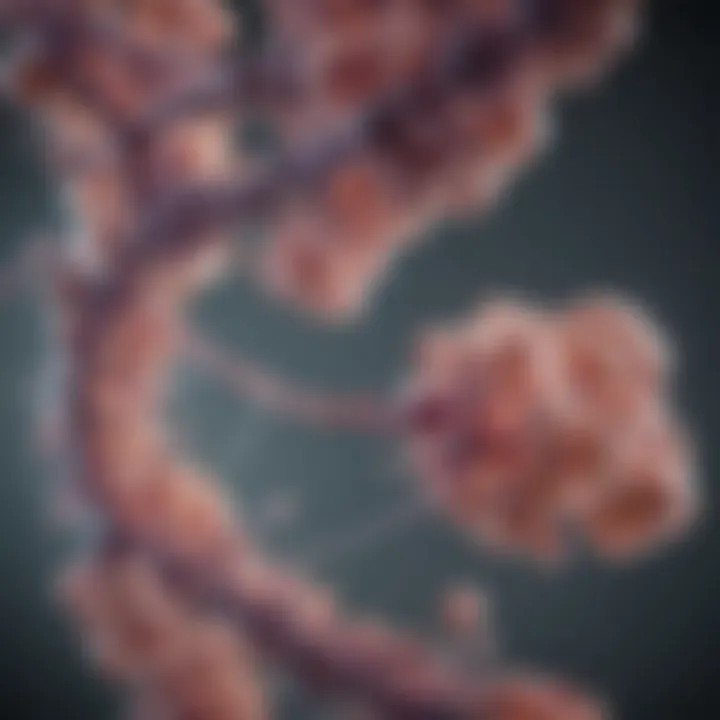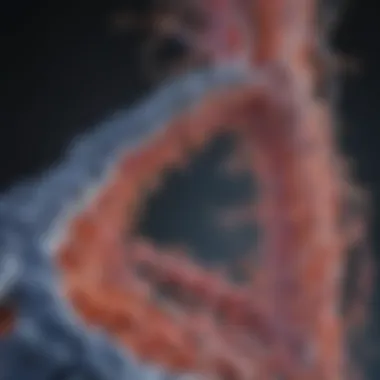Proline and Lysine: Vital Amino Acids in Biology


Intro
Understanding the roles of amino acids in biological systems is akin to piecing together a complex puzzle. Proline and lysine, two amino acids of considerable importance, each play critical roles in a variety of life processes. From metabolic pathways to protein synthesis, their influence stretches far and wide, impacting health and cellular function in ways that merit close examination.
In this voyage through biochemistry, we aim to dissect the nuances surrounding proline and lysine. We will explore not just their structures and functions but also how they contribute to overall well-being. As we peel back the layers, the significance of these amino acids will come into clearer focus, underpinned by scientific findings and contemporary research.
Particularly in a world where nutrition and biology intersect, understanding these fundamental components gains importance. This narrative serves those in academia, research, and professional disciplines, providing a wealth of knowledge about proline and lysine that extends far beyond basic definitions.
Foreword to Amino Acids
In understanding biological systems, amino acids stand out as fundamental building blocks, playing pivotal roles in various physiological processes. This article aims to shine a light on two specific amino acids—Proline and Lysine—while setting the stage by exploring the broader importance of amino acids.
Definition of Amino Acids
Amino acids are organic compounds that serve as the constituents of proteins. Each amino acid has a basic structure, which includes a central carbon atom linked to an amino group, a carboxyl group, a hydrogen atom, and a distinctive side chain or R group that varies among different amino acids. There are twenty standard amino acids, each contributing uniquely to protein structure and function.
In a nutshell, think of amino acids as the letters of an alphabet. Just as different combinations of letters form words, the specific arrangements of amino acids in proteins dictate their structure and function in living organisms.
Importance of Amino Acids in Biology
Amino acids are crucial for life as they are essential for not just protein synthesis but also for numerous biological functions. The significance of amino acids extends beyond mere structural components:
- Protein Synthesis: Proteins, made up of long chains of amino acids, perform a variety of functions essential for life, including catalyzing biochemical reactions and providing structural support.
- Cell Signaling: Certain amino acids function as signaling molecules. They help cells communicate, enabling a coordinated response to environmental changes.
- Nutrient Absorption: Amino acids aid in the absorption of other nutrients. For example, some are necessary for the transport of trace elements and minerals into cells.
- Regulation of Metabolic Pathways: Amino acids play regulatory roles in metabolic pathways, helping maintain homeostasis and energy balance.
It’s essential to consider these aspects when delving deeper into the roles of Proline and Lysine. Both of these amino acids contribute not only to protein composition but also to health and metabolic functions in unique ways.
Proline: Structural and Functional Overview
Proline plays a unique role in biological systems, standing out not just for its structure but also for its diverse functionalities. As a key amino acid, it is often involved in various processes that are vital for life. Understanding both its structural intricacies and functional applications is crucial for grasping how proline contributes to cellular roles. The significance of proline extends from its place in protein structure to its importance in cell signaling and osmoprotection. Thus, exploring the depths of proline's characteristics is essential in recognizing its value in biochemistry and medicine.
Chemical Structure of Proline
At first glance, proline possesses a distinctive cyclic structure, which sets it apart from other amino acids. Unlike its linear counterparts, proline features a five-membered ring that connects the amino group to the side chain. This configuration introduces rigidity to the polypeptide chain, playing a pivotal role in stabilizing protein structures. Notably, proline is classified as a nonpolar amino acid, which contributes to its unique behaviors in various environments.
Biosynthesis of Proline
The biosynthesis of proline is a fascinating process involving multiple pathways. It can be synthesized from glutamate through a series of enzymatic reactions. This typically includes the reduction of an intermediate compound, eventually resulting in proline. Notably, organisms can also derive proline through the recycling of proteins during cellular stress or damage. This self-sustaining ability showcases proline's resilience as an amino acid under various physiological conditions.
Biological Functions of Proline
Role in Protein Structure
Proline's significance in protein structuring cannot be overstated. It often acts as a structural anchor within proteins, promoting stability and influencing folding patterns. This unique capacity to introduce bends or kinks in polypeptide chains is a fundamental quality that allows proteins to acquire their functional conformations. Moreover, many structural proteins, like collagen, incorporate proline, underscoring its importance in maintaining the integrity of tissues.
Impact on Cell Signaling


Proline's role in cell signaling emphasizes its versatility. Research indicates that proline influences signal transduction pathways, particularly under stress conditions. Acting as a signaling molecule, proline can modulate cellular responses, ensuring adaptability during fluctuations in environmental parameters. This characteristic of proline positions it as a crucial component in the survival pathways of cells, effectively molding cellular responses dependent on their surroundings.
Proline as an Osmoprotectant
Another intriguing aspect of proline is its function as an osmoprotectant. Amidst environmental stress—such as high salinity or drought—proline accumulates in cells, functioning as an osmotic stabilizer. This adaptation helps maintain cell turgor and hydration, which is vital for cellular metabolism. The unique ability of proline to safeguard cellular integrity presents it as a beneficial compound, particularly in agricultural and medicinal research aiming to enhance stress tolerance in plants and other organisms.
"Proline serves not only as a building block of proteins but also as a vital player in cellular protection against osmotic stress."
As we unravel the roles of proline in biological systems, it's evident that this amino acid is far more than a mere structural element; its multifaceted functionalities make it indispensable in various life processes.
Lysine: Structural and Functional Overview
Lysine is an amino acid that plays an integral part in numerous biological functions. Understanding its structure and functionality is pivotal in revealing how it contributes to health and disease. Without lysine, various physiological processes cannot occur effectively. Thus, examining its unique properties provides insight into its essential roles in our body.
Chemical Structure of Lysine
Lysine is classified as a basic amino acid, characterized by its aliphatic side chain that contains an amino group. This structure contributes to its positive charge at physiological pH, enhancing its interactions with other biomolecules. Its formula, C₆H₁₄N₂O₂, showcases two amino groups in its structure, setting it apart from many other amino acids. The side chain, made up of a -NH₂ group, allows it to partake in various biochemical interactions. The physical structure also enables lysine to form hydrogen bonds, which is crucial in protein folding and stability.
Biosynthesis of Lysine
In humans and many other organisms, lysine cannot be synthesized de novo; hence it must be obtained through diet. Rich dietary sources include meat, fish, dairy products, legumes, and certain nuts. Various microorganisms synthesize lysine through metabolic pathways, a process notably important for consideration in agricultural and nutritional contexts. This highlights the necessity of including lysine-rich foods in a balanced diet to maintain sufficient levels for health and bodily functions.
Biological Functions of Lysine
Role in Protein Synthesis
Lysine's primary role centers around protein synthesis, where it contributes to the formation of new proteins. This amino acid is essential in the assembly of proteins, facilitating peptide bond formation. One significant characteristic of lysine in this aspect is its involvement in the translation process, where it ensures correct genetic information is translated into functional proteins.
The unique attributes of lysine in protein synthesis allow for a variety of protein functions, making it a significant player in cellular mechanics. A deficiency in lysine can lead to various health issues, including impaired growth and muscle wasting, underscoring its importance in nutrition and dietary concerns.
Contribution to Enzyme Function
Lysine also plays a critical role in enzyme function. It is known to be a part of many enzymes that catalyze vital biochemical reactions. The presence of lysine within these enzyme structures often aids in substrate binding and stabilizing enzyme conformation. This characteristic makes lysine crucial for enzymatic activity, impacting metabolic pathways and regulatory mechanisms. Its ability to form multiple types of bonds allows enzymes to maintain optimal structure for activity, highlighting its functional importance in metabolic processes.
Lysine and Immune Response
Recent studies suggest that lysine significantly impacts immune responses. It contributes to the production of antibodies and helps in the regulation of immune cell functions. One notable characteristic is lysine's role in enhancing the body's defense against viral infections, particularly herpes simplex virus. This suggests that adequate lysine levels may improve overall immune function.
Besides, the unique feature of lysine as a precursor to certain metabolites can offer additional advantages, potentially aiding in the modulation of inflammatory responses. However, excessive lysine intake can sometimes prompt imbalances, pointing toward the need for sensible dietary moderation.
"It's essential to understand how lysine impacts various biological systems, as this insight can lead to better nutritional choices and health outcomes."
Comparative Analysis of Proline and Lysine
Understanding the comparative aspects of proline and lysine sheds light on their unique contributions within biological systems. The exploration of these amino acids goes beyond mere structural analysis, unraveling how they interact within proteins and various metabolic pathways. This comparison allows researchers and educators alike to draw connections and contrasts that enhance our understanding of cellular functions and health implications.
Similarities in Function


Proline and lysine, while distinct in their own right, share some overarching roles in biological processes. Both are crucial for protein structure stability, though they assert their influence in different manners. Proline, due to its cyclic structure, introduces rigidity and unique angles within protein chains, aiding in the formation of secondary structures like alpha-helices and beta-sheets. Conversely, lysine, being a positively charged amino acid, facilitates numerous interactions through ionic bonds, thus playing a significant part in maintaining protein integrity.
Here are a few key similarities:
- Role in Protein Structure: They both contribute fundamentally to the three-dimensional configurations of proteins.
- Cellular Signaling: Proline and lysine participate in signaling pathways, albeit through different mechanisms, affecting processes such as cell growth and proliferation.
- Impact on Enzyme Activity: Each of these amino acids can serve as substrates or regulators in enzymatic reactions, which are pivotal in metabolic pathways.
Their commonalities underscore why understanding both is vital for diverse fields ranging from molecular biology to medicine.
Differences in Metabolic Pathways
Despite their similarities, proline and lysine diverge significantly in their metabolic pathways, which sharply defines their respective roles and impacts. Proline can be synthesized from glutamate via several enzymatic steps, allowing cells to adjust its levels based on metabolic needs. This pathway links proline metabolism directly to the broader network of amino acid metabolism, ensuring its availability during stress conditions, like those encountered in harsh environments.
In contrast, lysine cannot be synthesized by humans and must be obtained through diet, primarily from protein sources like meat, fish, and legumes. This necessity highlights its significance in nutrition and emphasizes the importance of consuming adequate amounts.
Some distinctive features of their metabolic pathways include:
- Biosynthesis Route: Proline originates from glutamate, whereas lysine’s synthesis follows a different, more complex path involving other intermediates like alpha-ketoglutarate.
- Functional Outcomes: The metabolism of proline is often linked with osmotic balance and stress response, whereas lysine metabolism is critical for production of important compounds like carnitine, which plays a crucial role in fat metabolism.
- Nutritional Aspects: The metabolic role of lysine emphasizes its essentiality, making it a focal point in dietary studies and health assessments.
Understanding these differences provides depth to our knowledge of how organisms utilize each amino acid to navigate through various physiological needs.
Impact on Health and Disease
Understanding the impact of proline and lysine on health is crucial as these amino acids play significant roles in various biological functions. Their relevance spans across essential physiological aspects, including amino acid metabolism, immune response, and overall cellular health. Analyzing their deficiency and its consequences reveals how vital they are to maintaining bodily functions. Furthermore, recognizing their roles in specific diseases can guide research towards better treatments and understanding of these conditions.
Deficiency and Its Consequences
Proline Deficiency
Proline deficiency can lead to several health issues, primarily due to its role in collagen synthesis. When there’s not enough proline, the body struggles to maintain skin elasticity and joint function. A key characteristic of proline deficiency is its link to delayed wound healing. This particular aspect warrants attention as it exemplifies how an insufficient amount of this amino acid can directly impact recovery processes in the body. A beneficial choice for this article, discussing proline deficiency highlights its connection to collagen production, which is vital for all connective tissues.
In cases of proline deficiency, the unique feature is how it can stunt growth in young individuals. Since collagen is integral in bone and tissue structure, a lack of proline can lead to irregularities that impede proper development. The disadvantage here is that it can often go unnoticed until the effects are quite severe, making it essential to stress the importance of sufficient proline intake for overall health.
Lysine Deficiency
Lysine deficiency also imposes significant health consequences. This amino acid is essential for protein synthesis, hormone production, and immune function. One of the critical aspects of lysine deficiency worth emphasizing is its potential to lead to impairments in mental function and mood disorders. Consequently, understanding this deficiency contributes to discussions on mental health and nutritional needs.
A notable characteristic of lysine deficiency is its contribution to reduced calcium absorption, which can lead to decreased bone density over time. This is a particularly alarming downside of inadequate lysine levels, as it not only affects immediate health but also raises long-term risk for osteoporosis. Its unique feature resides in the fact that lysine supplementation can significantly improve health markers, making it a focal point in dietary studies. By emphasizing how lysine impacts nutrient absorption and mental health, this article draws attention to vital connections between nutrition and well-being.
Role in Disease States
Proline and Cancer
Proline's connection to cancer illustrates its dual role in biology—it can be both a promoter of growth and an inhibitor during different stages of tumor evolution. Some studies suggest that elevated proline levels may support the metabolism of cancer cells. This aspect highlights the ongoing debate about whether promoting proline in treatment can hinder or encourage cancer progression.
A key takeaway is the metabolic reprogramming that cancer cells undergo, which often increases their dependence on proline as a carbon source. Understanding this relationship not only sheds light on cancer biology but also opens avenues for therapeutic interventions that target proline metabolism in tumors. This notion makes it a popular choice for exploring molecular cancer treatments.


Lysine and Cardiovascular Health
Lysine’s impact on cardiovascular health is another crucial consideration worth discussing in this article. Research has indicated that proper levels of lysine can influence cholesterol levels and may play a role in maintaining a healthy blood pressure range. A pivotal characteristic here is its potential to reduce the risk of atherosclerosis. This offers valuable insight into how dietary factors can impact heart health over the long term.
The unique feature of lysine in the context of cardiovascular disease involves its interaction with the amino acid arginine. Together, they can balance nitric oxide levels, contributing to improved vascular function. This shows how understanding lysine’s role can lead towards beneficial outcomes in heart health, emphasizing its importance in dietary considerations.
Overall, the health implications of proline and lysine deficiencies highlight the necessity for proper dietary intake in promoting vigorous health and preventing disease.
Research Developments in Proline and Lysine
Research into proline and lysine has taken significant strides in understanding their complex roles and effects within biological systems. These amino acids do not only serve as building blocks for proteins, but they have also been identified as key players in various metabolic pathways, impacting everything from cellular function to overall health. Researchers continue to explore the nuances of how proline and lysine influence biochemical processes, providing insight into their potential therapeutic applications.
Studying the roles of these amino acids is paramount, especially when considering their implications in health and disease. Exploring recent studies allows us to gain a clearer picture of how proline and lysine interact within biological systems and their broader implications on phenomena such as cellular signaling, metabolic regulation, and even chronic diseases. With ongoing research, the potential for these amino acids to be harnessed in clinical settings is becoming increasingly apparent.
Recent Studies on Proline
Recent inquiries into proline have unveiled intriguing aspects of its functionality. One significant area of focus is the connection between proline metabolism and cellular stress responses. It is recognized that proline not only contributes to protein stability but also plays a pivotal role during times of cellular stress, acting as an osmoprotectant. A study published in the Journal of Cell Biology explored how elevated proline levels can mitigate damage from osmotic stress, providing cells a buffer against unfavorable conditions.
Furthermore, another notable piece of research highlighted proline's role in promoting wound healing. By promoting collagen synthesis, proline proves its importance beyond mere structural roles. Individuals with elevated proline levels showed accelerated healing rates in clinical trials, suggesting a direct advantage of this amino acid in rehabilitation scenarios.
The implications of proline in neuroprotection have also come to light. A growing body of evidence indicates that proline may exert protective effects against neurodegenerative diseases. This has opened doors to further explorations into its potential role as a dietary supplement or even a therapeutic agent for conditions like Alzheimer's disease.
Recent Studies on Lysine
Lysine has also captured the attention of researchers in recent years, primarily due to its critical involvement in protein synthesis and regulation of metabolic pathways. One of the striking discoveries comes from studies focusing on lysine's influence on immune function, particularly its role in modulating inflammatory responses. It has been established that lysine can augment the immune system's response by enhancing the production of antibodies, thus offering protection against various pathogens.
Additionally, scientists are increasingly examining lysine's implications in cardiovascular health. Research has shown that lysine may inhibit the formation of advanced glycation end-products (AGEs), harmful compounds that contribute to cardiovascular diseases. A study detailed in the American Journal of Clinical Nutrition elaborated on how dietary lysine intake correlates with reduced risks of heart-related ailments, underscoring its potential importance in maintaining cardiovascular fitness.
Moreover, lysine's function in the biosynthesis of carnitine, which facilitates fatty acid metabolism, has garnered attention. Studies suggest that sufficient lysine levels could support metabolic health, encouraging the exploration of dietary interventions that ensure adequate intake of this essential amino acid for weight management and energy regulation.
"The multiple roles of proline and lysine in cellular processes highlight the necessity for ongoing research to fully understand their contributions to health and disease."
As the scientific community delves deeper into these amino acids, the findings not only enhance our understanding but could also lead to innovative therapies and dietary recommendations tailored to bolster health. The interplay between proline, lysine, and biological processes is a dynamic field ripe for exploration.
Finale
In this exploration of proline and lysine within biological systems, the discussion has revealed their multifunctional importance in life processes. As key amino acids, their structural properties influence not just protein architecture but also pivotal metabolic pathways that impact health and disease. The insights gained through this examination underscore the necessity of proline and lysine in maintaining homeostatic balance.
Summary of Key Findings
The thorough analysis throughout this article highlights several critical elements:
- Proline serves not only as a structural molecule aiding collagen formation but also plays roles in cellular signaling, impacting how cells communicate and respond to environmental stressors.
- Lysine, on the flip side, is integral to protein synthesis and has a part in activating enzymes that are essential for biological reactions.
- Deficiencies in these amino acids can lead to significant health issues, such as impaired immune response or weakened tissue structure.
- Research indicates that enhancing dietary sources of proline and lysine could promote better health outcomes.
The awareness of amino acid roles in biological functions emphasizes the importance of dietary inclusion, which can potentially be a game changer in health management.
Future Directions in Research
Looking forward, the frontier of research surrounding proline and lysine is vast and promising. Potential avenues include:
- Understanding the nuanced interactions between these amino acids and cellular processes in greater detail, which could unravel novel mechanisms behind disease prevention.
- Investigating the implications of proline and lysine supplementation in various health conditions, including metabolic disorders and chronic illnesses.
- Exploring the role that microbiomes play in synthesizing these amino acids from dietary proteins, adding another layer to their importance in nutrition.
Delving deeper into these areas can pave the way for innovative therapeutic strategies, improving our grasp on how nutrition influences biological systems in a critical way.







